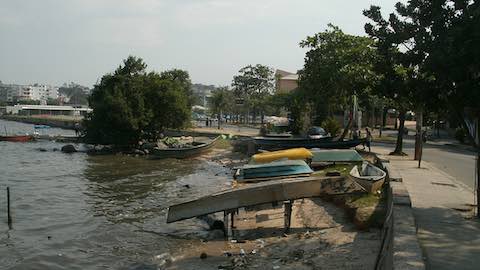- MENU
- HOME
- SEARCH
- WORLD
- MAIN
- AFRICA
- ASIA
- BALKANS
- EUROPE
- LATIN AMERICA
- MIDDLE EAST
- United Kingdom
- United States
- Argentina
- Australia
- Austria
- Benelux
- Brazil
- Canada
- China
- France
- Germany
- Greece
- Hungary
- India
- Indonesia
- Ireland
- Israel
- Italy
- Japan
- Korea
- Mexico
- New Zealand
- Pakistan
- Philippines
- Poland
- Russia
- South Africa
- Spain
- Taiwan
- Turkey
- USA
- BUSINESS
- WEALTH
- STOCKS
- TECH
- HEALTH
- LIFESTYLE
- ENTERTAINMENT
- SPORTS
- RSS
- iHaveNet.com: Environment

Dangerous, Dirty Water: Health Threat Around the World
by Sabrina Perry
After winning the Olympic bid, Brazil's government promised to clean up the water in Rio. This didn't happen. Visitors and citizens pay the price.
A putrid stew of untreated sewage, trash and bacteria, Rio's Guanabara Bay -- the site of Olympic rowing and sailing events -- still falls drastically short of sanitation levels promised for the games.
After winning the Olympic bid, the Brazilian government promised to treat 80 percent of sewage that flows into Guanabara Bay. But that promise has been left unfulfilled. Now, experts have warned water-sport athletes to keep their mouths closed and heads above water.
Simply put, the Brazil that won the Olympic bid is not the same Brazil that's hosting in 2016.
So, how did we get here?
The 2014 recession and continued government corruption massively altered Brazil's seemingly prosperous economic landscape from 2009. Seven years later, athletes, spectators and local inhabitants will pay the price.
Human adenovirus, a pathogen ubiquitous in areas contaminated by human feces and raw sewage, causes fevers and upper respiratory tract infections. In many of Brazil's Olympic waters, it still presents at levels thousands of times higher t han what would cause concern on a California beach.
Using the most recently available data (2014) from the Associated Press' investigation of Rio's waters, HealthGrove, a health data and visualization site by Graphiq, examined the toxic levels of this pathogen in the various competition sites.
The Olympic games always seem to be a double-edged sword.
They showcase the greatest possible feats of human athleticism while simultaneously exposing cracks in the pavement of our existence.
In Beijing, it was air pollution. In London, it was inadequate security. In Sochi, it was poor infrastructure. Now, in Rio, it's the water.
Brazil isn't even known for it's lack of water accessibility. According to data from the World Bank, there are 73 countries with worse access to improved drinking water sources. These sources include water from a piped house connection, public standpipes and boreholes, to name a few. Non-improved sources include unprotected wells, springs and surface water.
Despite the fact that 98.1 percent of the Brazilian population supposedly has access to improved drinking water sources, the country has hundreds of thousands of people living, fishing and swimming in water contaminated by sewage.
In countries like Tanzania or Mongolia, where access falls to a mere 55.6 and 64.4 percent, respectively, it's unpleasant to imagine what those living conditions look like. And those aren't even in the top five for countries with the worst access.
For people who have never had to worry about water, the severity of this problem may be hard to grasp. Unfortunately, the water crisis is a global issue, even if it's currently concentrated in certain countries.
According to environmental scientist Dr. Arjen Y. Hoekstra for the New York Times, "[freshwater] scarcity is a major risk to the global economy, affecting four billion people directly, but since the remaining people in the world receive part of their food from the affected areas, it involves us all."
Though the Olympic Games have put a fleeting spotlight on the problems in Rio, water accessibility remains a persistent problem around the globe.
WORLD | AFRICA | ASIA | EUROPE | LATIN AMERICA | MIDDLE EAST | UNITED STATES | ECONOMICS | EDUCATION | ENVIRONMENT | FOREIGN POLICY | POLITICS
Environment: "Dangerous, Dirty Water: Health Threat Around the World"